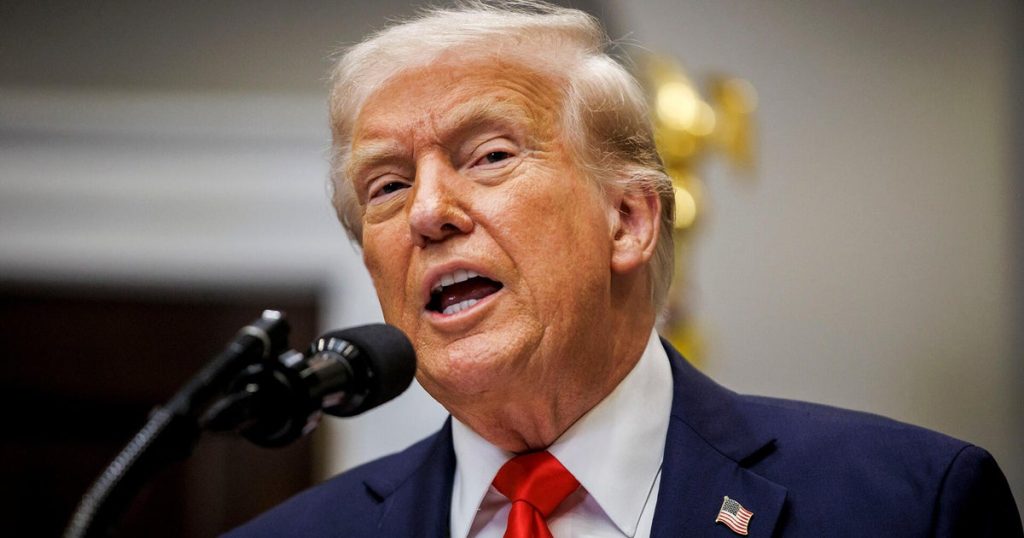In recent statements, President Trump has defended his administration’s tariff policies amid criticism of rising consumer prices and slowing economic growth. In a recent interview, he claimed that these policies had led to a record influx of nearly $9 trillion in investments into the United States. However, a thorough examination of these claims reveals inconsistencies and a lack of supporting evidence, calling into question the accuracy of the figures presented by the White House.
| Article Subheadings |
|---|
| 1) Claims of Record Investments |
| 2) Debunking the Trump Administration’s Claims |
| 3) Comparing Investments Under Different Administrations |
| 4) Understanding the Broader Context of Investment Announcements |
| 5) The Importance of Long-Term Policy Impacts |
Claims of Record Investments
During a recent interview on NBC’s Meet the Press, President Trump stated that he attributed approximately $9 trillion in investments to his administration’s policies. He characterized this figure as unprecedented when compared to previous administrations, boasting about the significant financial commitments that had allegedly flowed into the U.S. economy since his inauguration on January 20.
Though substantial investment announcements have indeed occurred over this period, the veracity of Trump’s $9 trillion claim is in question. Analysts and experts have pointed out that many of the investment commitments cited by the Trump administration predated his presidency, raising doubts about the actual impact of his policies on these figures.
Debunking the Trump Administration’s Claims
The Trump administration’s assertion that it secured $5 trillion in U.S. investments during its first 100 days needs further scrutiny. The White House published a list titled “The Trump Effect,” suggesting that these investments were directly tied to the administration’s economic policies. When closely examined, it became evident that the list amounted to about $2 trillion from private companies and roughly $5 trillion when foreign commitments were included—instead of the claimed $9 trillion.
Moreover, some notable entries on this list were projects announced prior to Trump taking office. For instance, a substantial $4.1 billion investment by Novelis for a plant in Alabama was already underway, with the announcement made long before his presidency began. After an inquiry from journalists, the White House removed this project from their website, although it had initially been included as part of the Trump administration’s economic accomplishments.
Comparing Investments Under Different Administrations
In repeated statements, Trump has compared his supposed investment successes in two months to the four-year terms of President Biden, insinuating that he attracted more capital within a significantly shorter time frame. Nevertheless, substantial evidence to corroborate these claims remains absent. The Biden administration announced that the private sector committed about $1 trillion to various clean energy and manufacturing projects throughout Biden’s tenure, thereby introducing a legitimate comparison point.
However, it is crucial to note that Biden’s reported investments came from specific project announcements within industries such as green energy, semiconductors, and pharmaceuticals. These projects are often backed by granular data, including clear timelines and locations, distinguishing them from the less specific pledges outlined by the Trump administration.
Understanding the Broader Context of Investment Announcements
Experts highlight that merely announcing planned investments does not guarantee future action. As noted by Nick Nigro, founder of Atlas Public Policy, companies frequently make such announcements to demonstrate their commitment to the United States, perhaps to gain favor with a new administration. This trend applies to both Trump and Biden’s presidencies.
Looking back, many claims of investment during Trump’s presidency were later revealed to be projects initiated during previous terms. For instance, Eli Lilly had already begun investments that the Biden administration cited as successes during its own term. This consistent pattern raises questions about the nature of these announcements and their direct correlation to specific administration policies.
The Importance of Long-Term Policy Impacts
During his tenure, President Biden enacted significant legislation, such as the Inflation Reduction Act and the CHIPS and Science Act of 2022, which included substantial tax incentives aimed at attracting investment. These measures are expected to yield long-term benefits and commitment towards domestic manufacturing. The sustained impact of these policies, however, may take years to fully materialize and be measured.
Experts warn against the impulse to directly link announced investment plans to the policies of the Trump administration at this juncture, arguing that the relationship remains speculative at best. The full economic implications of these policies—including those from prior administrations—will require time and careful analysis to evaluate.
| No. | Key Points |
|---|---|
| 1 | Trump claimed nearly $9 trillion in investments attributed to his administration’s policies. |
| 2 | A deeper analysis suggested discrepancy, with total investment commitments falling significantly short. |
| 3 | Many investments cited were previously announced and initiated before Trump’s presidency. |
| 4 | Biden’s investment commitments are based on more detailed project announcements compared to Trump’s broader pledges. |
| 5 | Long-term effects of investment policies will require careful evaluation over time. |
Summary
The scrutiny of President Trump’s claims regarding investment figures indicates a complex interplay between political narratives and economic realities. As both past and current administrations vie for economic credit, the true impact of their policies may take time to discern fully. Understanding the nuances of investment announcements, alongside the long-term consequences of legislative efforts, will be crucial in accurately assessing the landscape of U.S. economic investments moving forward.
Frequently Asked Questions
Question: What are the claimed investments attributed to Trump’s administration?
President Trump claims that nearly $9 trillion in investments were spurred by his administration’s tariff policies and economic strategies.
Question: How do Trump’s claims compare to Biden’s reported investments?
Trump asserts he attracted more investment in two months than Biden did during his entire term; however, Biden’s reported commitments are based on specific project investments, while Trump’s are broader pledges.
Question: Why is timing critical in the analysis of these investments?
The timing is vital because many investments claimed during Trump’s presidency were announced prior to his inauguration, complicating the narrative surrounding the effectiveness of his policies.
